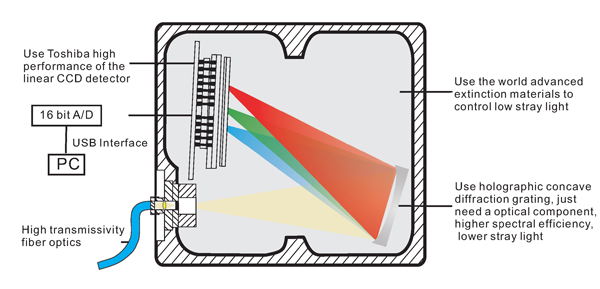Product No: LMS-9000C
LMS-9000C High Precision CCD Spectroradiometer is according to LM-79 clause 9.1. It is designed for any visible optical spectrum distribution analysis, mimicking various light sources in the visible region by feedback control of the radiant power emitted by individual LEDs. This LED optical spectrum analyzer is used as a transfer standard for photometric, colorimetric and radiometric applications.
LMS-9000C can do quick test with high accuracy. It used in scientific lab. It works with integrating sphere and standard lamp as a system: LPCE-2 High Precision Spectroradiometer Integrating Sphere System.
Standard:
CIE 177 “Color Rendering of White LED Light Sources”
CIE84 “The measurement of luminous flux”
CIE-13.3 “Method of Measuring and Specifying Colour Rendering Properties of Light Sources”
LM-79-19 “Optical and Electrical Measurements of Solid State Lighting Products”
IESNA LM-63-2 “IESNA Standard File Format for the Electronic Transfer of Photometric Data and Related information”
IES LM-80-08 “Measuring Lumen Maintenance of LED Light Sources”
ANSI-C78.377 “Specifications for the Chromaticity of Solid State Lighting products for Electric Lamps”
(EU) 2019/2015 “COMMISSION DELEGATED REGULATION”
Measurement:
• Colorimetric: Chromaticity coordinates, CCT, Color Ratio, Peak Wavelength, Half Bandwidth, Dominant Wavelength, Color Purity, CRI, CQS, TM-30-24 (Rf, Rg), Spectrum Test
• Photometric: Luminous Flux, Luminous Efficiency, Radiant Power, WPE, EQE, EEI, Energy Efficiency Class, Pupil Flux, Pupil Flux Efficiency, Pupil Factor, Cirtopic Flux, Plant Growth Lamp PAR and PPF
• Electrical: Voltage, Current, Power, Power Factor, Displacement Factor, Harmonic
• LED optical maintenance test: Flux VS time, CCT VS time, CRI VS time, Power VS time, Power Factor VS time, Current VS time and Flux Efficiency VS time
Specification:
• Spectral Wavelength Accuracy: ±0.3nm, Wavelength Reproducibility: ±0.1nm
• Sample Scanning Steps: ±0.1nm
• Accuracy of Chromaticity Coordinate (Δx, Δy): ±0.002 (under Standard A Lamp)
• Correlated Color Temperature CCT: 1,500K~100,000K, CCT Accuracy: ±0.3%
• Color Rendering Index Range: 0~100.0, Accuracy: ±(0.3%rd±0.3)
• Luminous Flux Range: 0.01-200,000lm; Photometric linear Accuracy: ±0.5%
• Stray light: <0.015%(600nm) and <0.03%(435nm)
• Integration Time: 0.1~10,000ms
• It can measure the temperatures inside and outside of integrating sphere
• Total flux testing method: spectrum, photometric and spectrum with photometric revision
| LISUN Model | LMS-9000C | LMS-9000CUV-VIS | LMS-9000CVIS-NIR | LMS-9000CUV |
| Wavelength | 350-800nm | 200-800nm | 350-1050nm | 200-400nm |
The LMS-9000C (which is updated on LMS-9000B) uses the band pass-filter wheel correcting technique, spectrometer & broadband-radiometer & photometer combined technique, and modified NIST stray light correction technology. The LMS-9000C spectroradiometer can realize ultra low stray light and super photometry linearity in overall dynamic range.

LISUN LPCE-2(LMS-9000C) High Precision Spectroradiometer Integrating Sphere System – After-sales Frequently Asked Questions (FAQ).
LISUN LPCE-2(LMS-9000C) High Precision Spectroradiometer Integrating Sphere System were in the market for more than 10 years, LISUN engineers service team already summary the most of the After Sales Questions and Answers in the above link. Please read it carefuly, you can solve the most of the problems by yourself if you have some questions while using the instruments. LISUN will be continue to update this pages and more FAQ can be found in this topic link.
